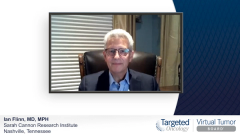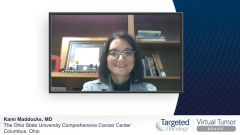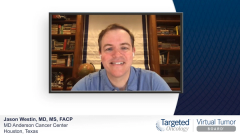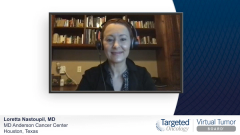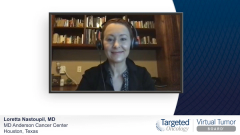
Case 3: Third-Line Treatment Options for DLBCL
Kami Maddocks, MD: The first question for discussion, would you continue to use anti-CD20 therapy after first relapse? And if so, would you choose rituximab or another agent?
Jason Westin, MD, MS, FACP: We don’t have a lot of data on other CD20 antibodies being better than rituximab. We had the frontline GOYA trial, which compared R-CHOP [rituximab plus cyclophosphamide, hydroxydaunorubicin, vincristine, prednisone] versus G-CHOP, [obinutuzumab plus cyclophosphamide, hydroxydaunorubicin, vincristine, prednisone]. It showed an equivalence—it wasn’t better or worse; it’s more expensive. There’s not a clear reason to switch to a different CD20 for patients with large-cell lymphoma. If they don’t respond to R-CHOP [rituximab plus cyclophosphamide, hydroxydaunorubicin, vincristine, prednisone], it’s not clear that they would do better with other CD20 antibodies plus other chemotherapy in the future. I generally continue rituximab for these patients if I plan to give them salvage therapy.
Kami Maddocks, MD: We’ve answered the next question on experience and challenges of using CAR [chimeric antigen receptor] T-cell therapy in this type of patient. If we were not able to get this patient to CAR T, what would be your preference? One of these regimens that we’ve talked about, or something else from the NCCN [National Comprehensive Cancer Network] guidelines? And then looking at these different treatment options, what would you choose for this patient, or how would you sequence these therapies? I know there are no great data. But what would your approach be to this patient, and what would be the key benefits or challenges for each of these therapies?
Ian Flinn, MD, MPH: My preference would be to take this patient and give them tafasitamab and lenalidomide rather than one of the other options, at least on the next line of therapy. As we talked about earlier, this patient has a chemotherapy refractory disease, and then there’s an appeal to using a different mechanism of action. The tafasitamab and lenalidomide serve that need.
Polatuzumab vedotin, the data there, not exactly in this patient, are impressive. But ultimately, that’s giving the patient targeted chemotherapy mediated through the antibody. Giving this patient tafasitamab, lenalidomide would be attractive. There isn’t any right or wrong for which order to give this drug to this patient. I don’t know. I’m less excited about selinexor. As we saw, the results are not nearly what you see with the other drugs, the less than 30% overall response rate, the median progression-free survival was low. I would put that therapy further down the line.
Loretta Nastoupil, MD:What’s most impressive about the tafasitamab, [lenalidomide] data is overall survival. It looks good, particularly in relapsed large cell lymphoma. Now the caveat is they excluded primary refractory patients, they excluded double hits. We don’t know how this patient would have performed on that regimen. But it is the most interesting to me among the options we have. Again, one other exception that I might consider, polatuzumab, rituximab, and CAR T, if I can get that patient here. Again, bendamustine, I agree with Jason, is not my most exciting drug in the relapsed large cell space. I don’t know how well polatuzumab, rituximab performs without it, but it is something that I’ve tried a few times and have had some success with.
The toxicity profile with selinexor, and the way the study was conducted where they completely excluded any of our refractory patients, has dampened my enthusiasm around it.
Jason Westin, MD, MS, FACP: Just to defend selinexor, even though I did say it’s quite toxic, it’s an oral agent, which is the advantage there for patients who don’t want to come in for an infusion, or don’t live near a center, or have to drive 4 hours each way to get there, that’s one advantage for it. But otherwise, I agree with the comments that there are potentially better options for these patients. There’s not a clear way yet for us to choose among these agents. Sometimes it becomes a bit of muscle memory of which one you have used before, which one you have experience with. But it’s great to have this problem, that we have multiple agents approved in this space. There are more to come. There are plenty of promising agents, so this is a problem that’s going to grow over time. Hopefully we’re curing more patients in the front line with novel therapy, so we don’t have as much need in third line. But clearly it’s good to have these problems.
Kami Maddocks, MD: I agree. Right or wrong, I look at selinexor as one of those options that if a patient is not eligible for a clinical trial, you’ve use other things, and they want to try something. It’s an oral therapy, it’s something that is potentially going to work, and so why not go ahead and try it if the patient wants to?
In our other discussions, we’ve made it clear that we look at this as 2 different populations of patients. If a patient is eligible for a curative therapy, be it transplant or CAR T, they should be evaluated in an attempt at that curative therapy. If they’re not going to be candidates, or progress after, or you’re having trouble getting them there, then these are the times that we want to think about these other options. The overall survival in tafasitamab and lenalidomide is very promising, and maybe with more follow-up that will be a more frequently used treatment, including with more data on some of these more refractory patients.
I look at this as 2 different populations of patients. There are 2 different goals of the care or treatment. I don’t know if everybody would agree with that to some extent, or have other thoughts.
Jason Westin, MD, MS, FACP: I agree with you, Dr Maddocks. CAR T-cell therapy is such a transformative therapy for this patient population in the sense that we can now confidently say we’re curing people with relapsed/refractory large cell lymphoma with chemotherapy refractory disease, where before this was a dismal prognosis. These new therapies do have incredible promise, and there is hope that some of these impressive progression-free survival curves may mean some patients could be cured with these therapies. But we don’t know. And you’re right, that if you can give CAR T cell, you really owe it to your patient to refer them to a CAR T-cell center to have that discussion. Patients will come back to you, they don’t stay with us. They get CAR T-cell therapy, and then we help care for them afterward. There are no compelling reasons not to offer CAR T cell to somebody, or at least have them be screened for it, if you think they’ve got a potential for going for a cure.
Kami Maddocks, MD: Yes, we certainly have much better options than we did even 2, 3 years ago, and it’s made it nice to be able to offer these to patients. But we have a long way to go, and hopefully some of the bispecific antibodies and other therapies we’ll see will help us further improve outcomes.
In closing, I would like to thank all the panel members for your thoughtful case presentations and lively, informative discussion. To our viewing audience, thank you for joining us for this Targeted Oncology™ Virtual Tumor Board® presentation, and we hope you acquired some practical knowledge that you can take back to your clinic.
Transcript edited for clarity.



